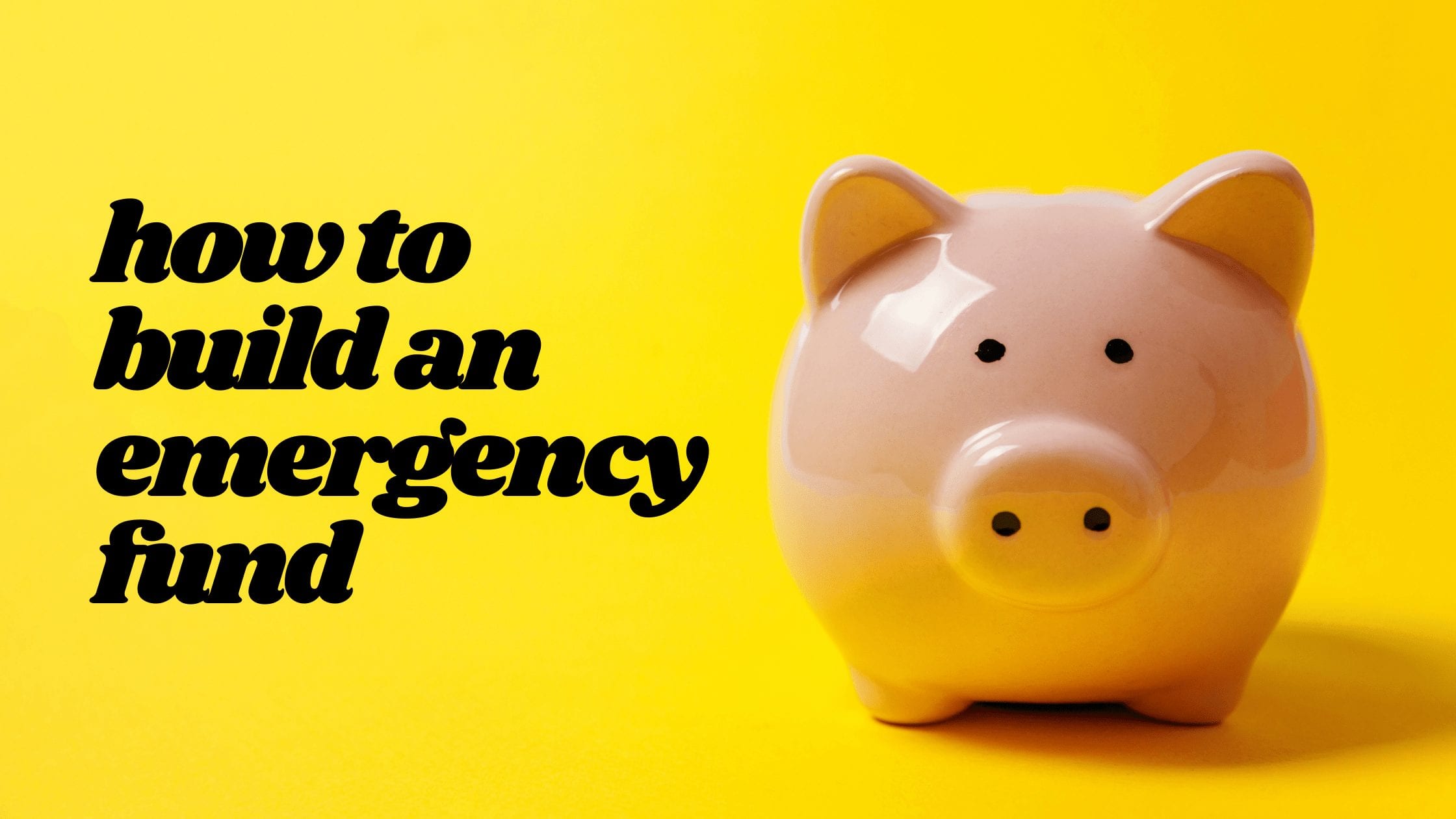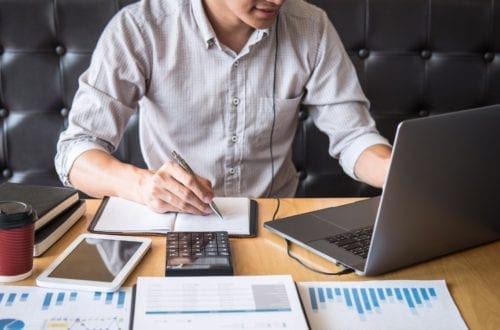
How to Build an Emergency Fund in 6 Easy Steps
As an Amazon Associate I earn from qualifying purchases. We may earn money or products from other companies mentioned in this post at no cost to you!
Reading Time: 6 minutesDid you know that, according to Yahoo!finance, less than 70% of Americans have less than $1,000 saved for emergencies?! Wow… if there was ever a wake up call that you need to have an emergency fund, 2020 has given us all the reasons.
Because of a global pandemic, businesses were ordered to close to the public, people were being laid off because there is no ability to work, Congress took too long to implement a relief package to American families… this is truly something we’ve never seen before.
I feel like I’m no stranger to economic upheavals. I started my banking career right as the Recession was hitting my state (great timing, yes?). I was even laid off for a week before (thank goodness!) being called back to work. I had moved to a new city and had only been there for nine months before that week-long layoff. I had no connections, no one was hiring because the economy was in a tailspin, and I was feeling desperate.
I joke now that it was only one week but it forever traumatized me. Having an emergency fund, which I didn’t have at the time, would’ve helped relieve some of my stress.
When I worked with businesses, my colleagues and I would refer to an emergency fund as “the war chest”. As most know, the recovery after the recession was slow, but 2017-2019 were stellar years! The businesses I worked with were making more money than they ever had in their existence, went from being small to medium-sized businesses, and were just happy to ride the economic highs. We were busier than ever like there was no stopping. We no longer had any seasonal slow-downs, we were always busy. Despite all that, my colleagues and I kept warning our clients to build their war chest. Why? We wanted them, even though times were really, really good, to have some caution and build a cash reserve in case there was ever an economic hiccup… cue COVID-19 and the 2020 year.
We need to be applying the same mentality in our own households. Even though we may not have employees relying on us for a paycheck (although maybe some of you are business owners), we may have loved ones who rely on us for financial security. It is important that we’re building our war chests- our emergency funds- for ourselves and our families.
(See this article about expecting the unexpected by Brandon at Rinkydoo Finance)
Even as a single woman, I knew that I was my only financial back up. I had no one else on whom I could rely if I lost my job. I had to make sure I could afford my mortgage and buy my food because there was no one else to take care of me.
Here are some tips to get your “war chest”, your emergency fund, started.
Know your actual expenses
How much would be a good amount to put in savings? For starters, look at your checking account and/or credit cards and see what your average spending is per month. If you’re already budgeting, you should know what our monthly expenses are.
Start small- a couple of weeks to a month’s worth of savings that could cover your expenses. I’ve heard the “save $1,000 for emergencies and use the rest of your money to pay down debt” plan, and you can do that. However, I don’t know about you, my emergencies are rarely only $1,000. For most, that doesn’t even cover rent, and I don’t know of any landlords that take credit cards. I would suggest a higher number than to start with.
If you don’t have a budget yet, you should at least be able to miss a couple of paychecks. That should be a bare minimum. If your net pay in a month is $3,000, start with $3,000.
Now that you know your goal, move on to the next step.
Open an account at a place that’s hard for you to get to
This step is key to making sure you don’t raid your emergency fund. If it’s money that can be easily transferred to your regular checking account, you’ll find that you’ll keep having “emergencies”!
There are financial institutions out there that have no physical branches, they’re online banks only. You can still access this money via electronic transactions. It takes three days to electronically move money from those accounts via ACH or writing a check to yourself, so the friction makes you less likely to pull that money out. Or, you could choose an institution that is not conveniently located for you.
One such bank is CIT Bank. I choose this one because they generally have higher interest rates than most because they’re an online only bank! If you’re going to park your money somewhere, at least try to get as much interest as possible from it! Here’s a link for you if you want to open an account at no cost to you.
If you want to shop around, I recommend using SuperMoney to find an account with a bank you probably don’t currently bank with and can give you a higher interest rate. SuperMoney allows you to comparison shop for an account with the best terms to fit your situation. If you’re going to have a large chunk of money sitting in an account long-term, may as well try to earn something on it! Check out this link to get a money market set up. You may even find one with a sign-up bonus, as well!
I personally keep my emergency savings in institutions that I don’t normally bank with, and I occasionally move it around if I can get a good sign-up bonus or really good interest rate. I can move the funds electronically from these accounts to my regular bank account and it’s never been issue for me.
Put your savings on autopilot
You know what amount you want to save up to, and you’ve set up your account in a place that’s safe from you (Ha ha!), now comes the execution.
I think the easiest way to get yourself to save money is to have it auto-drafted into that emergency savings account. If you get direct deposit, you can usually split up your paycheck to go to different accounts. Ask your payroll department if you don’t know how to do this.
Set aside an amount from each paycheck to go to that account. The best way to determine what this amount is should be determined by your budget. If you don’t have a budget set up yet, don’t let that hold you up from starting your savings.
A product my husband used before we were married to help him start a savings account was the Digit app. You can set it up to take a few cents (or more) here and there from your checking account and put it in a savings account. They do these little amounts based on your spending habits. You don’t really notice it, especially if you’re not on a budget yet, and you’ll have money saved in no time! This is truly auto-pilot. If you want to try it out, click this link!
If you’re feeling aggressive, can you spare $100 to put in your savings? If that seems too much, how about $25? How about $10? Those little things add up if you leave it alone, but do try to set aside a meaningful amount.
Expecting extra money?
If you know you’re going to be getting a tax refund, use that to boost your savings! (But see my post about why you shouldn’t want a tax refund.)
Got stuff to sell? List it on OfferUp (my favorite!) and add that money to your savings.
I’ve opened up bank accounts to take advantage of a promotional offer and used that to add to my emergency funds. Check out SuperMoney to see if there are any offers that you can take advantage of!
Get creative about looking for ways to build that emergency fund.
See this post to get extra money for your emergency savings by actually opening an account!
Keep adding to that account!
Don’t stop at one or two paychecks saved, keep going! If you do have debt that needs to be paid off, maybe only have one or two month’s worth of paychecks saved is fine for now, because paying off debt is also a high priority! Once that debt is gone, take what you were sending as payments and put it into that emergency fund instead!
If you use the Digit app, adjust your settings to take more and keep slowly building that fund up. Here’s the link again if you want to try it out!
You’ve heard the “3 months” or even “6 months” of expenses to be saved as a general rule. I personally feel that an adequate emergency fund should have at least 12 months worth of expenses, but maybe you feel 6 months is sufficient. Others may think that it should 2 years worth of expenses. My personal preference, and what I would make a goal, would be 12 months worth.
Conclusion
Most of the time, our emergencies are going to be cars breaking down or possible job loss. Considering all the once in a lifetime events that I’ve now experienced in my short years (9/11, Great Recession, COVID-19), we can’t think that emergencies aren’t going to happen to us. We need to heed the warnings while we can do something about it.
I hope this was helpful. Let me know in the comments of any tips that have worked for you!
RELATED
See this post for budgeting your savings.
See this post for the accounts you should have to execute your budget successfully.
IF YOU WANT TO SEE MORE…
Consider subscribing to my e-mail list. You can always unsubscribe, I won’t spam you!
Follow me on Facebook, Instagram, or Twitter
Save this post on Pinterest by using the share buttons, and follow me, too!
If you want to start a blogging business, check out this FREE course!
If you want to make money from a blog, check out this program that got me started making my own money blogging!






61 Comments
Teresa somewhere in the Gorge
Thanks for the excellent information! You explained it so well – anyone could understand what you were saying without a degree in finance!
Alice
This is sound advice. I’m in a transition period and moving to a larger city. I will have to look at my budget again when I get settled.
Ashley
“They” say it takes about 6 months to adjust to big changes like that, but I think being prepared helps!
Lisa Manderino
I feel like I learned a lot from the last recession as well. We are trying to save for that rainy day!
Ashley
What a crazy time it was, for sure.
Kelly
Great post ! I’m sure that week felt like years and we can laugh about it now but it definitely wasn’t funny then. The good thing is that it was a wake up call for people to take action for emergency situations. I know someone daving is hard for some especially if you’re living paycheck to paycheck but making small goals and increasing them over time is the best way to start m thanks for putting this together.
Brianna
Yes it’s been a difficult year for many people and it is important to have money.
Ashley
It is! I think the big goal is overwhelming to some so they never start. You just gotta start, and then take small steps.
Lisa Willis
For extra income, I have used OfferUp to sell a few household items. These are some great ways to build an emergency fund.
Ashley
I feel like I mention OfferUp a lot, maybe I’m reallllly into it, ha ha!
Beth Shields
Great ideas for sure. And knowing what your budget is – so critical. Thanks for sharing this.
Ashley
I know, all the boring things you hear about personal finance- but they work!
Ramae Hamrin
Great tips here. I had no idea that a person could split up their direct deposit paycheck into different accounts. What a fabulous way to save money!
Ashley
If your workplace doesn’t do it, see if you can set up an automatic transfer on the days you know you get paid. If they do, I think it’s so helpful psychologically because you never see the money hit your account so you don’t really think about it!
Sydney Delong
Another smart idea is to take all of your monthly expenses, and have enough in your emergency fund to pay for those expenses for 3-6 months! We do have an emergency fund, but I think I need to make it a bit larger.
Ashley
Yup! I think of that as job loss security.
Megan
Great ideas! Unfortunately, we just used a bit of rainy day savings for fixing our car. But it was nice to know we had that savings reserved for such a thing.
Ashley
Hey, that’s what they’re for! But I get it, it hurts to pull that money out after you worked so hard to save it.
Leeandra
Great tips! It’s always great to have an emergency fund!
Ashley
Definitely!
April
This is. Great topic to talk about especially now that a lot of the society lose their job. We have to learn to have some savings Incase of emergencies. Great point and something to think about.
Ashley
I feel for everyone going through this. I’ve been through that and still traumatized!
Holly
Fantastic tips and advice! It’s so important to have an emergency fund and be able to be confident that you are safe financially!
Ashley
Having that security is key!
Jill DeMasi
It’s so important to have a little cushion to rely on when needed especially when you are a small business owner. I set up an automatic transfer that goes into my savings account 2 times per month.
Ashley
Good for you! That’s the way to do it, in my opinion. Almost like a bill that you’re obligated to pay.
Brianna
Obviously it’s important to have money. I meant that it’s important to save money.
Ashley
Definitely. Who knows what else 2020 has in store for us!
Tiffany Smith
I love having savings on auto pilot! If its up to me to transfer it, sometimes it doesn’t happen….
Ashley
Same! Then it’s a nice surprise when you see how much has accumulated.
Beth
We’ve been pretty good at following these tips – though working on a system to track actual expenses that works for us — and still working on not having a tax refund.
Ashley
Good for you! I think you start with something and just keep tweaking until it suits your specific situation.
Sabrina DeWalt
We have been very good about saving. It is very rewarding when there is an emergency to actually have the money to deal with it. I must say, though, that I don’t like pulling that money even to take care of the emergency. LOL
Ashley
I know! When you’ve worked so hard to actually save for emergencies, it still hurts to actually use that money, even for emergencies, ha ha!
Maria Gustafsson
Really great advice!
Ashley
Thank you!
Debbie
12 mos and don’t touch it! Wish I had heard this when I first got married.
Ashley
Well, then there’s me, who knew it and didn’t take it seriously. I’ve learned!
Chelsea
Having an emergency fund is a game changer for my stress level. Once I got to our first $1000 of an emergency fund I already felt better. But I didn’t really feel free until I got to the 3-6 month worth of expenses emergency fund. Knowing we have enough money in there that we won’t have to use a credit card is so comforting. And like you mentioned, we put it in a separate account from our day-to-day checking account.
Ashley
Such a stress reliever, for sure! Good for you guys!
Alyssa
Great information. I know a lot of people who just live above their means. I find it crazy how people don’t have savings, rainy day funds, or emergency funds. Thank you for sharing ways on how to learn to save!
Ashley
Sounds stressful, doesn’t it? I hope these posts get to the right people so they know they don’t have to live that way!
Kristin
Everyone absolutely needs an emergency account! Another great way to start one, if you don’t have any extra $$, is to start donating plasma. There are lots of ways to get it going if you purpose in your heart to just do it.
Ashley
I love unconventional ways to make money! Great idea!
Barbara
Gotta build up a safety net – ALWAYS! Great advice!
Ashley
Advice I wish I would’ve taken in my younger days! Thank you for the comment.
Maya
Great tips. My favorite is Tip#3 , smart way to save.
Ashley
Thank you! Glad you found it useful.
Marianne
So many great tips for saving for a rainy day! We actually use some of them as a way of saving up for our next family vacation!
Ashley
Same here! Glad you enjoyed it.
Jessica
Such an important topic for everyone to learn more about, great tips!!
Ashley
Thank you!
Cindy Mailhot
These are great ideas!
Ashley
Thank you!
Cindy Moore
These are great tips and such sound advice! This year has taught us the importance of having that emergency fund, for sure.
Ashley
Fingers crossed that we’ll all be ready for 2021!
CBD for pain
Hi there! This is kind of off topic but I need some advice from an established
blog. Is it very hard to set up your own blog? I’m not very techincal but I
can figure things out pretty quick. I’m thinking about making my own but I’m not sure where to
start. Do you have any ideas or suggestions? Many thanks
buy cbd gummies
Spot on with this write-up, I seriously believe this site needs a great deal more attention. I’ll probably be returning to read more, thanks for the info!
Also visit my webpage buy cbd gummies
best cbd gummies
Great blog you have here but I was wanting to know if you knew of any
community forums that cover the same topics talked about here?
I’d really like to be a part of group where I can get comments from other experienced people that share the same interest.
If you have any suggestions, please let me know.
Thank you!
cbd sleep
Have you ever considered about adding a little bit more than just your
articles? I mean, what you say is important and all. Nevertheless think
of if you added some great graphics or videos to give
your posts more, “pop”! Your content is excellent but with pics and
videos, this website could definitely be
one of the best in its field. Good blog!
Mark
Wow that was odd. I just wrote an extremely long comment but after I clicked submit my comment didn’t appear.
Grrrr… well I’m not writing all that over again. Regardless,
just wanted to say excellent blog!